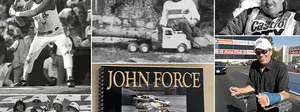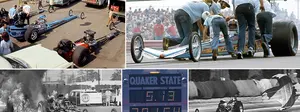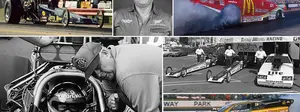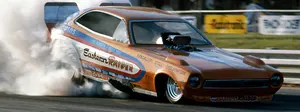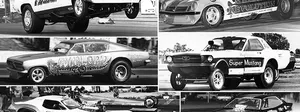

A Christmas (Tree) Story
|
|
 |
|
|
|
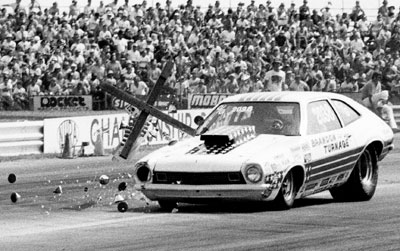 |
|
Eagle-eyed reader David Leighton, whose family for years ran California's Inyokern Dragstrip, pointed out an error in my recent column concerning NHRA's 1970 switch to a "Pro Start" system at that year's Supernationals at Ontario Motor Speedway.
In moving away from the five-amber countdown that, in retrospect, must have made life difficult for Top Fuel and Funny Car drivers, to a single-sequence start, I said that all five ambers flashed simultaneously, which, as Leighton pointed out, was incorrect. "Actually, only the fifth amber light was used," he noted. "It wasn't until the Tree was shortened to three ambers that the Pro Start was expanded to three ambers at once. Admittedly I do not remember when that took place, but another lost day in the archives could surely turn that up, too."
How could I turn down a challenge like that? And, this being Christmas time and all, why not a deeper look back at the Tree?
Any drag racing history buff worth his or her Wynn's Winder decal probably knows that the Tree made its official NHRA debut at the 1963 Nationals in Indy, where Don Garlits famously red-lighted away the Top Eliminator to unheralded Bobby Vodnik, who had "Big" covered by about a tenth going into the final.
Of course, for years, the colorful and acrobatic "flagman" had signaled the start of each race, but the flag starter system, popular with fans and racers alike, had its flaws. Foul starts were rampant as drivers flinched and left if the starter so much as accidentally blinked his eyes, and each starter had his own unique personality … and his "tells," as Garlits himself pointed out in his book tales From the Drag Strip: "We had all gotten pretty good at reading the flag starter just by watching his eyes. We could read the muscles in his arms and how they tightened up just before he threw the flag. … The older guys hated it when the Tree came in. We eventually adjusted to it, but we really didn’t want it." Plus there was talk, at smaller events away from the national limelight, of starter favoritism in sharing a pre-waving signal and outrage when a starter might inadvertently minutely change his normal procedure. Electronics was the answer.
The first NHRA Tree (initially known as the Countdown Starter) was designed by then Division 1 Director Lou Bond, and hyped in pre-Indy issues of National DRAGSTER: "Foolproof in design, the new innovation will be a boon to nervous drivers trying for the big win. … An equal start for all is assured."
The first Tree was pretty simple, with five amber lights, a red, and a green. There were no "pre-stage" or "stage lights" because, at the time, there was only one beam across the starting line. When the drivers got about a foot from it, the starter would activate the Tree, allowing drivers to pretty much invent the system of "shallow staging" or choose to roll in closer to the beam.
The pre-stage and stage lights and beams weren't far behind, introduced for the 1964 Winternationals and billed as "the automatic line-up system," though the pre-stage and stage bulbs weren't yet actually on the Tree, but rather positioned on the starting line itself.
The bulbs finally were added to the Tree over the next couple of seasons, but it wasn't until, as noted, the last race of the 1970 season that the Tree went from full to Pro start, with just the bottom of five amber bulbs lighting.
Other than component upgrades, the Tree stayed pretty much intact until the start of the 1986 season, where NHRA unveiled a new, streamlined Tree. It was shorter -– three ambers instead of five -- and placed farther out from the starting line. And, yes, Virginia, this was when NHRA also adopted the all-flash amber start.
The logic was part simple math and part in reaction to Pro Stock hood scoop development. Eliminating the two bottom bulbs of a Sportsman countdown saved one second per pairing, which added up significantly through a long day of time trials and qualifying, important back then as lighting systems weren't all they are today and even a few minutes bought back against impending darkness could mean the difference between a completed event and one interrupted by night.
|
|
|
The all-amber flash was a concession to many drivers, especially in Pro Stock, where they were having trouble seeing the bottom bulb over their hood scoops. There also was the convenience of not having to change focus greatly from the stage bulb to the bottom amber, and, more crucially, the extra bulbs made the start a little more fail-safe should that lone amber burn out or break, an ongoing problem that was also eventually addressed.
The last and most significant change came in 2003, when NHRA switched from incandescent bulbs to light emitting diode (LED) bulbs beginning with the season-opening Winternationals. The biggest knock on the incandescent bulbs was their constant failure due to vibration of the fuel-car exhausts that shattered their fragile filaments. Typically, NHRA was changing out an average of 20 bulbs per race, and with the stakes getting ever higher and the cars ever more complex, the last thing anyone wanted was to have to re-run a race because of a blown light bulb.
The event also gave stats hounds a mild coronary as NHRA switched to a .000 base for reaction times instead of the traditional .400 (the time difference between the ambers and the green), but the LEDs, more easily seen on bright days, were a boon to the driver's egos. The average Top Fuel and Funny Car reaction in 2002 was .508 but dipped to .075 and 079, respectively, at the end of 2003, a drop of more than .025-second. The Pro Stock class average dropped from .461 to .034. The Tree has remained basically unchanged since.
So, as you're enjoying the Christmas Tree in your living room this year, remember that its dragstrip namesake, too, took a lot of growing before it reached prime time.
























